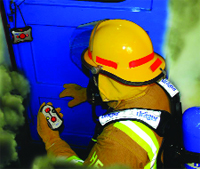
Equipment
New products
Draeger releases fireground tracking devices

January 25, 2008
By Draeger Safety KG & Co.
Draeger entered into an exclusive manufacturing and supply agreement in December with Exit Technologies of Boulder, Colo., developer of the Tracker FRT (Firefighter Rescue Transceiver) and ET (Egress Transmitter). Through this agreement, Draeger launched two fireground tracking products at the 2007 Fire-Rescue International show in Atlanta, under the names Draeger FRT 1000 and Draeger ETR 1000.
The Draeger FRT 1000 is a low-frequency 457 kHz radio transmitter and receiver both contained in the same handheld unit. The Draeger FRT 1000 is worn on the SCBA belt during fireground operations in conjunction with an integrated or stand-alone PASS device. When the firefighter stops moving for 60 seconds, it sends an electromagnetic distress signal that can be tracked by others on the fireground who are also wearing a Draeger FRT 1000. The signal transmission can also be activated manually by the distressed firefighter while issuing a Mayday. The low frequency distress signal transmits through walls and floors enabling fire fighters inside and outside the structure to rapidly track and rescue the downed firefighter.
The Draeger ETR 1000 is a transmit-only unit that can be placed at exits and other points of safety by the fire attack team or incident commander. The Draeger ETR 1000s can be used as "electronic breadcrumbs" by a distressed firefighter attempting reorientation or self-rescue. Each 1000 has one button for locating firefighters wearing Draeger FRT 1000s and one button for locating Draeger ETR 1000s. When switched from standby to search mode, a bright distance display and changing audible signal provide direction to the transmitting Draeger FRT 1000 or Draeger ETR 1000.
Almost 40 U.S. fire departments are already using this technology, originally developed for locating avalanche victims buried in snow.
Print this page